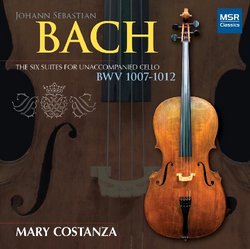| All Artists: Mary Costanza (violoncello) Title: Johann Sebastian Bach: The Six Suites for Unaccompanied Cello, BWV 1007-1012 Members Wishing: 0 Total Copies: 0 Label: MSR Classics Release Date: 4/12/2013 Genre: New Age Style: Number of Discs: 2 SwapaCD Credits: 2 UPC: 681585145029 |
Search - Mary Costanza (violoncello) :: Johann Sebastian Bach: The Six Suites for Unaccompanied Cello, BWV 1007-1012
 | Mary Costanza (violoncello) Johann Sebastian Bach: The Six Suites for Unaccompanied Cello, BWV 1007-1012 Genre: New Age
J.S. Bach composed the Six Suites for Unaccompanied Cello sometime around 1720 in Cothen, while he was in the service of Prince Leopold; one of the few times in his career when he was not working for a church. It was durin... more » |
Larger Image |
CD Details
Synopsis
Product Description
J.S. Bach composed the Six Suites for Unaccompanied Cello sometime around 1720 in Cothen, while he was in the service of Prince Leopold; one of the few times in his career when he was not working for a church. It was during this period that he wrote many of his famous secular pieces, including the Violin Sonatas & Partitas, the Brandenburg Concertos and the Well-Tempered Clavier books. There are no surviving manuscripts of the Cello Suites in Bach's hand. Fortunately, his second wife Anna Magdalena (who was an outstanding musician in her own right) also put the suites to paper, but without any indications of articulations or bowings. This was normal for the time, considering that it was common for players to freely interpret or improvise many aspects of the music. Each Suite consists of a Prelude followed by a sequence of French dances. The original intent of the pieces is unknown, though each numbered suite increases in difficulty and length. There is also no established performance practice; players typically perform them as a complete suite or as separate movements. Although today the Cello Suites are considered among the most familiar and profound of Bach s works, this was not always the case. For many years these pieces languished in obscurity, looked upon as technical exercises rather than legitimate repertoire. It took Pablo Casals' 1890 discovery of the Suites to bring them to the forefront of the musical world. As a boy searching for new music, he stumbled on an old Grutzmacher edition in a second-hand shop in Barcelona. Legend has it that he practiced the Suites for twelve years before performing them in public, and his seminal 1930s recording for EMI of the Complete Suites (still available today) secured their position in the canon of classical music. Born and raised in Fairport, New York, Mary Costanza studied with Lynn Khale Richmond, a graduate of the Curtis Institute and the Assistant Principal Cellist of the Rochester Philharmonic Orchestra. At age 17, Mary won the prestigious Albright Award sponsored by the Rochester Philharmonic and the Eastman Theatre and as a result performed Lalo's Cello Concerto in D minor as a soloist with the orchestra. During her high school years, she performed as Principal Cellist for the New York State Summer School of the Arts in Saratoga, New York. Costanza attended the Cleveland Institute of Music, where she received a BM degree under the tutelage of Stephen Geber, Principal Cellist of The Cleveland Orchestra. During that time, she regularly performed as a member of the Canton Symphony under the direction of Gerhardt Zimmerman and received fellowships to attend the Music Academy of the West in Santa Barbara, California and the Blossom Music Festival. After receiving her undergraduate degree, Costanza earned a fellowship to perform with the National Orchestral Association under the direction of Alvaro Cassuto. The NOA performed in Carnegie Hall for a full season of concerts sponsored by the New York Philharmonic and Columbia University in New York City. She also served as a member of the Rochester Philharmonic during their summer season at the Canandaigua Performing Arts Center. She was accepted to The Juilliard School where she studied with Zara Nelsova. Costanza was also awarded annual fellowships to the Aspen Music Festival to continue her studies with Nelsova. Mary holds a MM degree from Juilliard. Mary Costanza maintains a thriving private cello studio that serves students of all ages. She regularly presents solo recitals and performs with numerous ensembles in the Tri-State region. She is currently Assistant Principal Cellist of the Greenwich Symphony under the direction of David Gilbert, and served for many years in the Hudson Valley Philharmonic.

 Track Listings (18) - Disc #1
Track Listings (18) - Disc #1